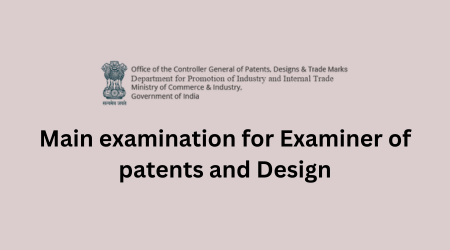The main examination for Examiner of Patents and Design-The answer keys have been released today on 11 February and will end on 13 February 2024. If Candidates are not satisfied with any answer key they can challenge it by paying Rs.200 per answer key.
You can follow the below steps to challenge the answer key
First visit the official website https://exams.nta.ac.in/DPIIT/
Click Challenge(s) regarding the Answer key
Login with your Application Number and Date of Birth, enter the security PIN as displayed and submit
Click Challenge(s) regarding the Answer key
You can see the Question IDs in the below sequence for the Main Exam(Paper I Only) i.e., Phase 2 for the Post of Examiner of Patents and Design
| GK and Current Affair | 1 to 20 | 20 Questions |
| General Aptitude | 21-40 | 20 |
| Elementary Mathematics | 41-60 | 20 |
| English Language Proficiency | 61-80 | 20 |
| Knowledge related to IPRs | 81-100 | 20 |
- The ID next to the question under the column ‘Correct Option’ stands for the most appropriate Answer Key by NTA.
- If you wish to challenge this option, you may use any one or more of the Option
- IDs are given in the next four columns by clicking the check box.
- You may upload supporting documents for which you can select ‘Choose File and
- upload (all documents to be put in a single PDF file).
- After clicking your desired option, scroll down and ‘Save your Claim’ and move to the next screen.
- You will see a display of all the Option IDs you have challenged.
- Click on ‘Save your Claim and submit. Select the Mode of Payment and Pay a non-refundable processing fee @ ₹ 200/- for each question challenged. Make payment through Debit/Credit Card/Net Banking
The Preliminary examination was held on 21 December 2023. The preliminary exam result will be declared soon on the website https://exams.nta.ac.in/DPIIT/
Check vacancies in Maharastra Pollution Control Board for Scientists and Sr.Scientist
The Schedule has been given below-:
| Level of Exam | Mode of Exam | Expected Date |
| Mains Paper-I | Computer Based Test (CBT) | 25 January 24 First Shift |
| Mains Paper-II | Descriptive Test (Offline) – 14 different disciplines | 25 January 24 Second Shift |
| Interview | Offline | To be Announced |
Scheme of Examination
| Level of Exam | Total Marks | Duration | Subjects |
| Mains Paper-I | 100 | 2 Hours | General Knowledge and Current Affairs (20 Marks), General Aptitude (20 Marks), Elementary mathematics (20 Marks), English language proficiency (20 Marks), and knowledge related to intellectual property rights (IPRs) (20 Marks) |
| Mains Paper-II | 300 | 3 Hours | Technical/scientific discipline of the vacancy applied for |
Main examination for Examiner of patents and Design
The dates regarding the release of the City Intimation Slip and Admit Card will be announced later on the website https://exams.nta.ac.in/DPIIT/ through a Public Notice.
As an Examiner of Patents and Designs, one of the primary responsibilities is to examine patent and design applications. This involves reviewing applications to determine whether they meet the legal requirements for patentability, which can include novelty, non-obviousness, and enablement. For design patent applications, ornamentality is also a necessary prerequisite. The examiner must conduct a thorough study of each application, including conducting prior art searches, to ensure that the application meets the applicable statutes and rules. This process requires a keen eye for detail and a deep understanding of patent law and the examination process.
Conducting prior art searches and patentability analysis is another critical duty of an Examiner of Patents and Designs. Prior art searches involve examining existing patents, publications, and other relevant materials to determine whether an invention is novel or non-obvious. By identifying relevant prior art, examiners can make informed decisions, strengthen patent claims, and avoid potential infringement issues. This process requires a strong research background and familiarity with various databases and search tools.
After conducting a thorough examination of an application, the examiner must issue an examination report detailing their findings and any objections or rejections. Effective communication with applicants is essential to ensure that they understand the examination process and the reasons for any objections or rejections. Examiners must be able to clearly and effectively communicate complex legal concepts to applicants and respond to any questions or concerns they may have. The examination process is computer-based.

